A lot of time is spent, in various forums and professional social settings, discussing when one should move with a firearm. But it seems not a ton of time is spent on discussing how to move with one. Sure, you hear things like “explosive movement off the X,” which roughly translates into “go fast in any direction.” This is one thing we feel the martial arts community does better than the firearms community — good martial arts instructors will explain everything in terms of leverage, force application, and body mechanics. Much of what we accept as conventional wisdom in the shooting world is anecdotal, or at least passed down anecdotally and accepted based on the pedigree of the source.
About Full Spectrum Warrior
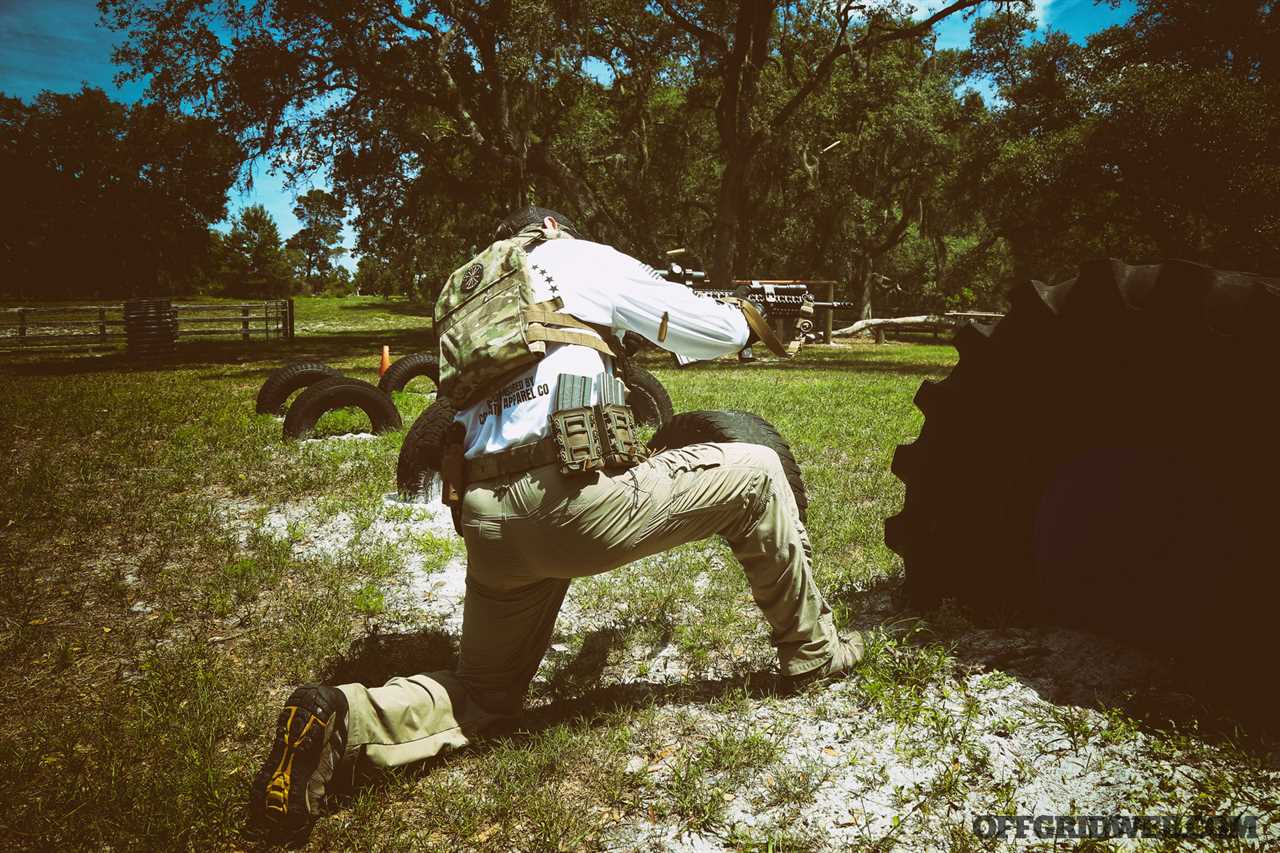
Occasionally, you’ll come across trainers who are both skilled in firearms and possess a deep background in martial arts and/or strength training. Enter Full Spectrum Warrior, founded by former Navy SEAL Rich Graham. He offers a number of training courses in both firearms and combatives topics, but one of his flagship curricula is the Combat Mobility System. Coauthored with strength coach and martial arts trainer Greg Mihovich (read more about his unique story in RECOIL OFFGRID Issue 49), the Combat Mobility System approaches movement and body positioning from a kinesiological perspective, offering some unique methods of movement and positioning.
Last year, I had the chance to visit Full Spectrum Warrior and spend several days with both Rich and Greg reviewing the Combat Mobility methodology. It’d be impossible to capture the entirety of their three-day program in a single article, but I wanted to highlight a couple of the lessons I learned while working with FSW to learn the details of their Combat Mobility System.
Body Positioning
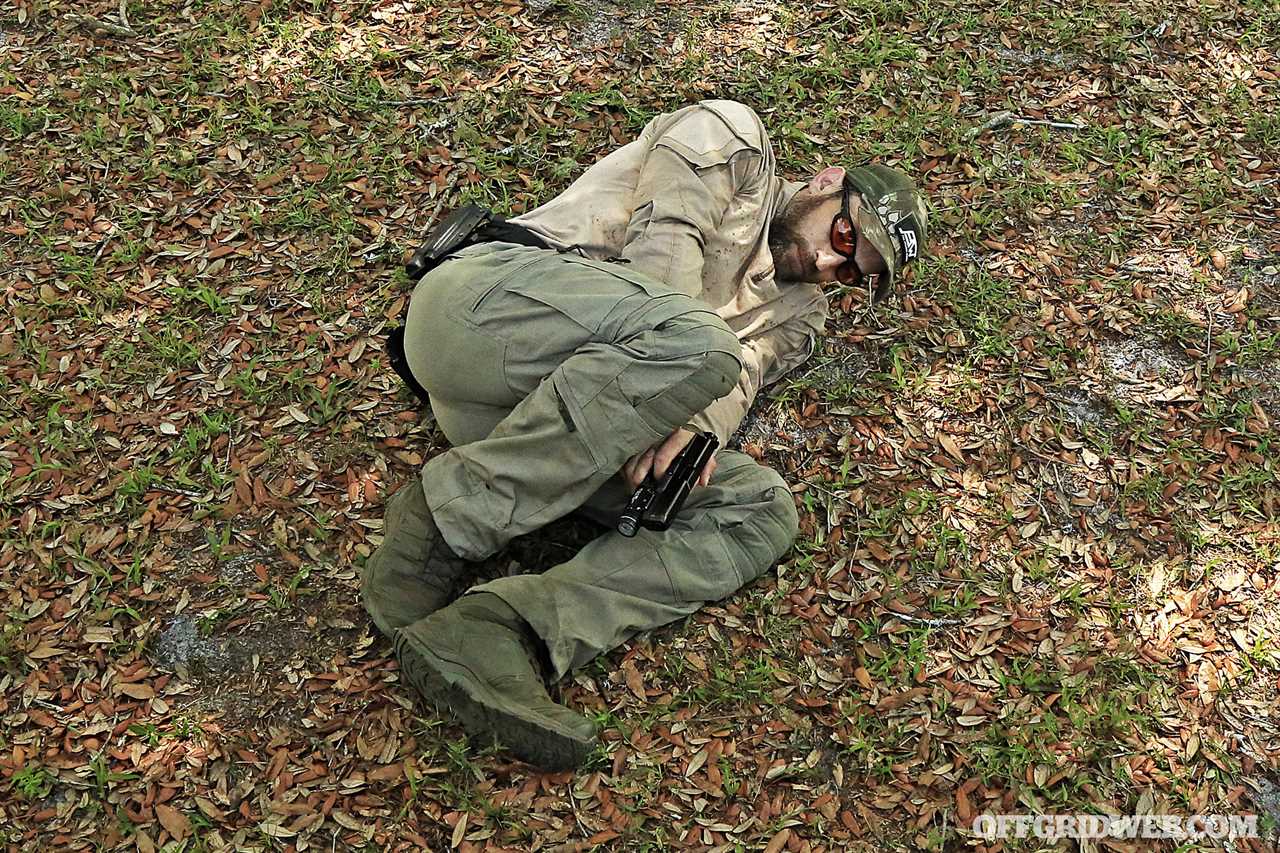
Above: Stability is key to shooting quickly and accurately in awkward positions. Actively engaging the feet and knees in “urban prone” with a pistol creates additional control for more effective shooting.
Our review of the Combat Mobility System started with an in-depth discussion on various body positions. “Stance” is one of the seven fundamentals of marksmanship as taught by the military, and for good reason. If you think of your body as a platform or chassis that the gun is dropped into, having a mechanically sound body position is part of what enables you to make consistent hits and effectively manage recoil. Regardless of whether you’re standing, crouching, kneeling, or prone/supine, building a body position that’s stable and sustainable — in other words, you’re not fighting your own body to hold the position — is important for successful marksmanship.
We reviewed everything from baseline upright stance to sitting, kneeling, crouching, prone, urban prone, and supine, with an examination and discussion of how to engage your body in the shooting process. When shooting a pistol from the urban prone, Mihovich demonstrates bracing your forearms or elbows against the inside of your legs and hooking your feet together. This method, as opposed to simply laying on your side and extending your arms out, creates three additional points of contact (each arm against each leg, and feet locked) and allows you to engage your larger leg and pelvic muscles to help stabilize the pistol.
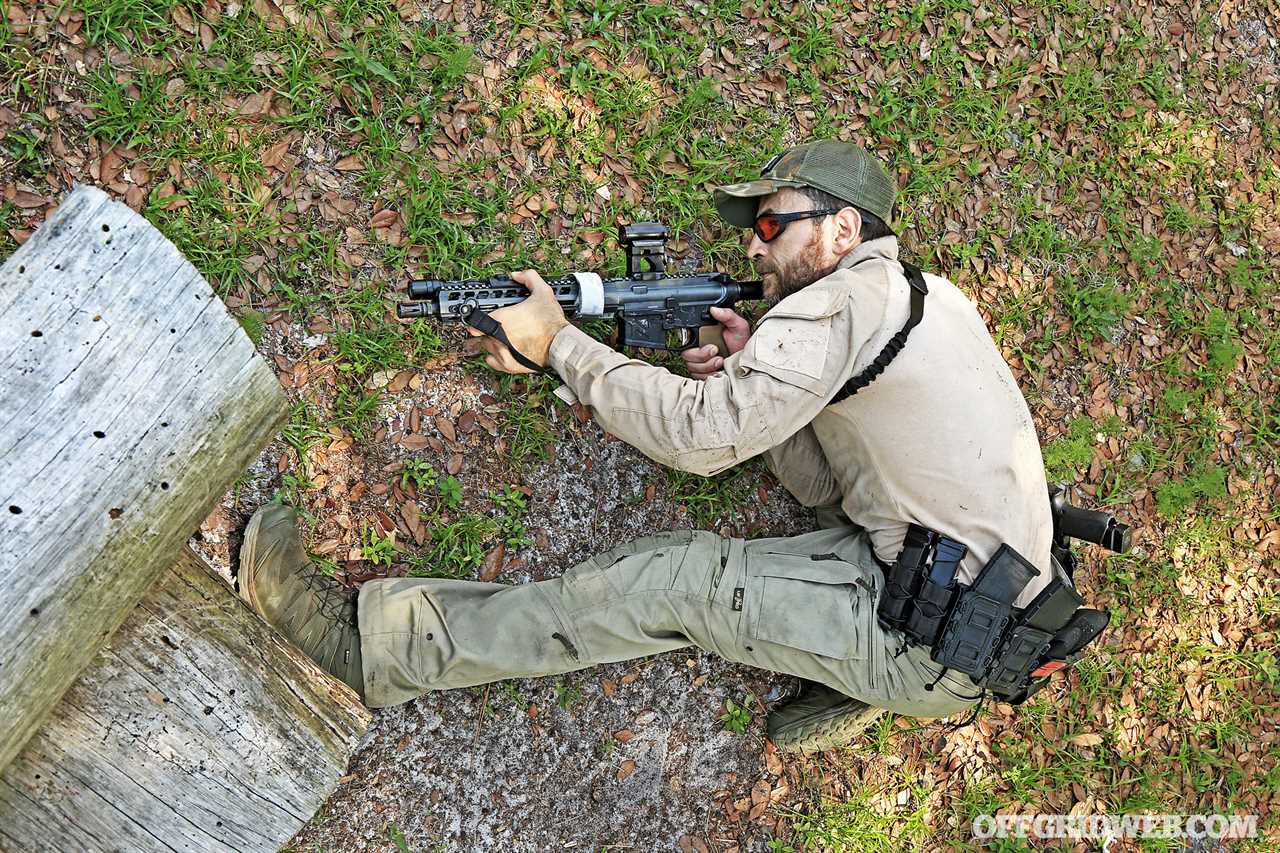
Above: Bracing off cover also contributes to stability while shooting and can provide a physical index for properly mounting barriers or obstacles.
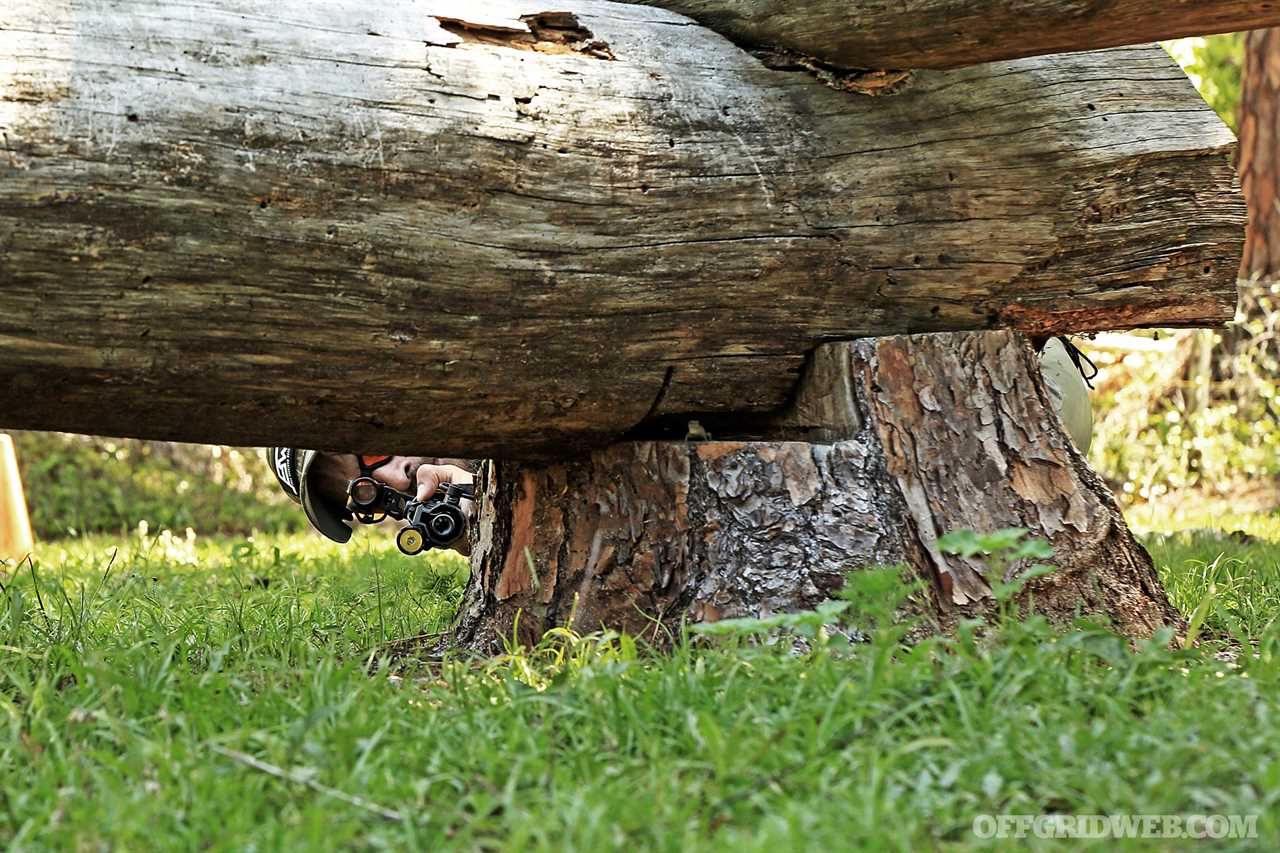
Above: This image shows the shooter's minimal exposure to target in the position shown in the previous image.
In the context of combative or defensive shooting, it’s also important to give yourself the most stable platform possible while minimizing how much of your own body you expose to potential incoming or return fire. If possible, use cover or concealment barriers to create additional points of contact, and keep your body compact to minimize exposure. If it’s not possible to use a stable object or barrier, maximize the number of body-to-ground and body-to-body contact points to create stability.
This point also factors heavily into how you change positions. The best example I saw in class was moving from standing to prone. When I was still on active duty, I was instructed that the best way to transition from standing to prone was to “get as low as you can and kick your back legs out behind you to drop into the prone.” Like much misguided military instruction, this lesson was punctuated with the tough-guy cop-out “if it hurts, you’re doing it right!”
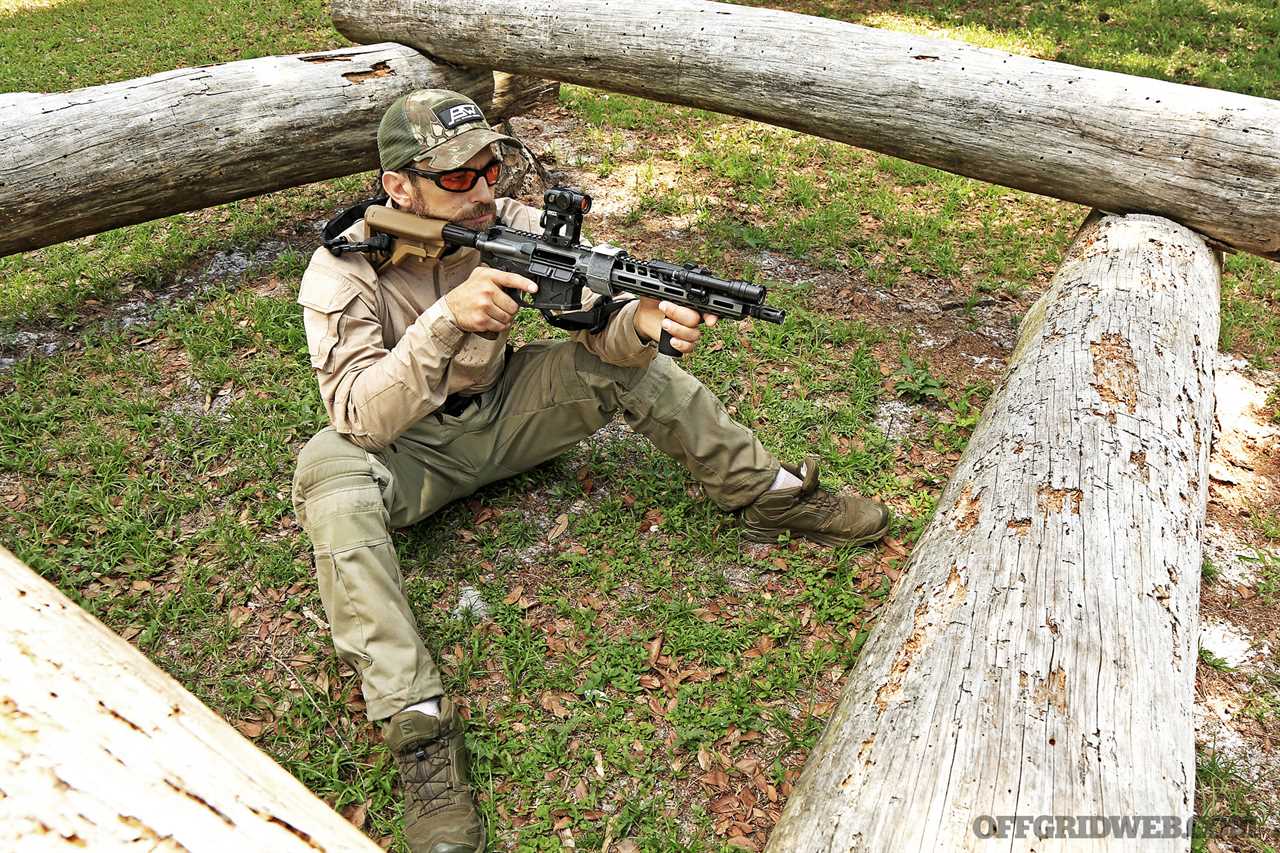
Above: Seated positions are inherently stable and can be adjusted to minimize how much of a target you present.
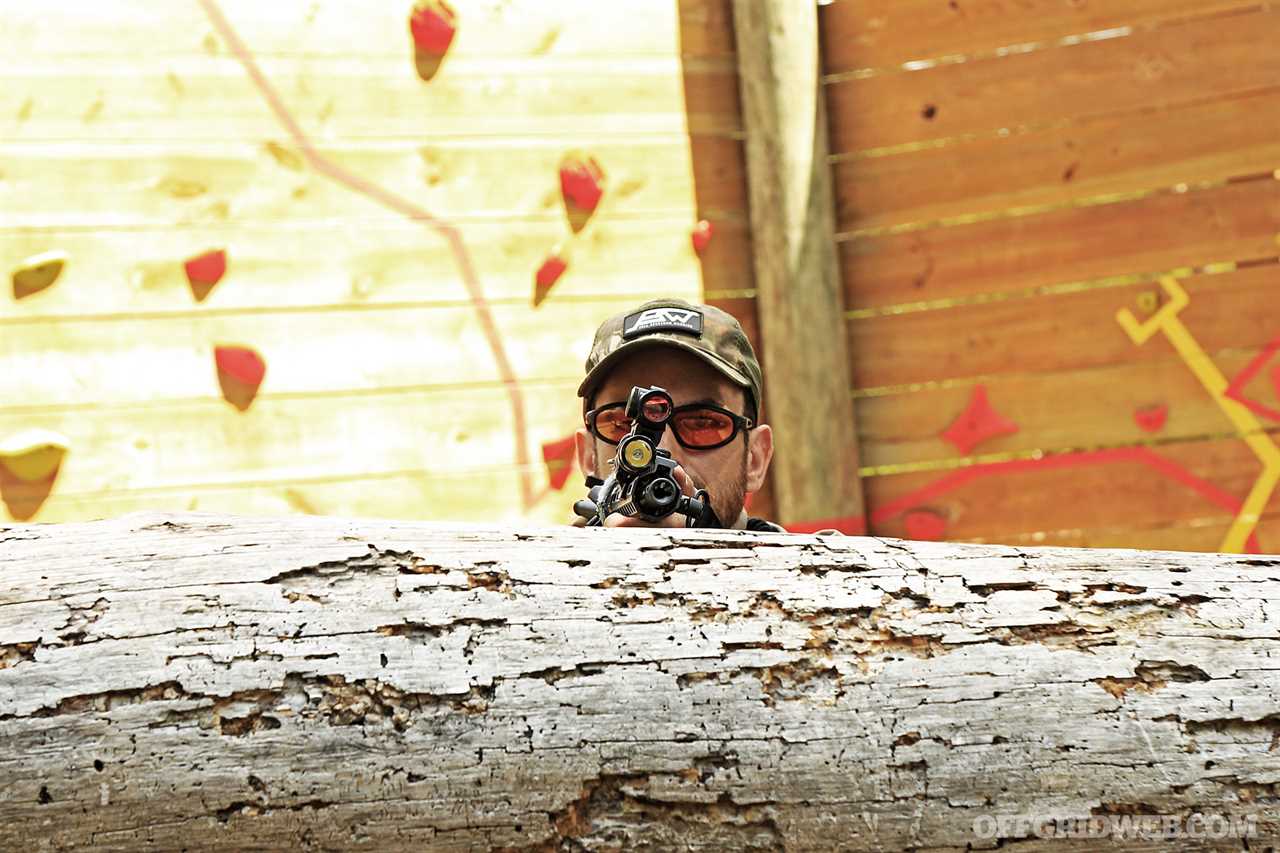
Fortunately, Full Spectrum Warrior has developed a more methodical approach. Instead of dropping all your mass down in the dirt in one uncomfortable, unsmooth, painful burst of motion, simply collapse your body’s natural anchor points into the ground from the feet up. First a knee, then a hip, then torso and upper triceps, then simply roll onto your elbows. Not only is this a safer, less injurious way to switch positions but if the situation changes rapidly, you could, theoretically, “pause” on any of those major anchor points (knee, hip, abdomen, triceps) to return fire or even just reassess the situation.
In the following sequence, Graham demonstrates his method for transition to prone, meant to reduce impact on the joints from dropping straight down:
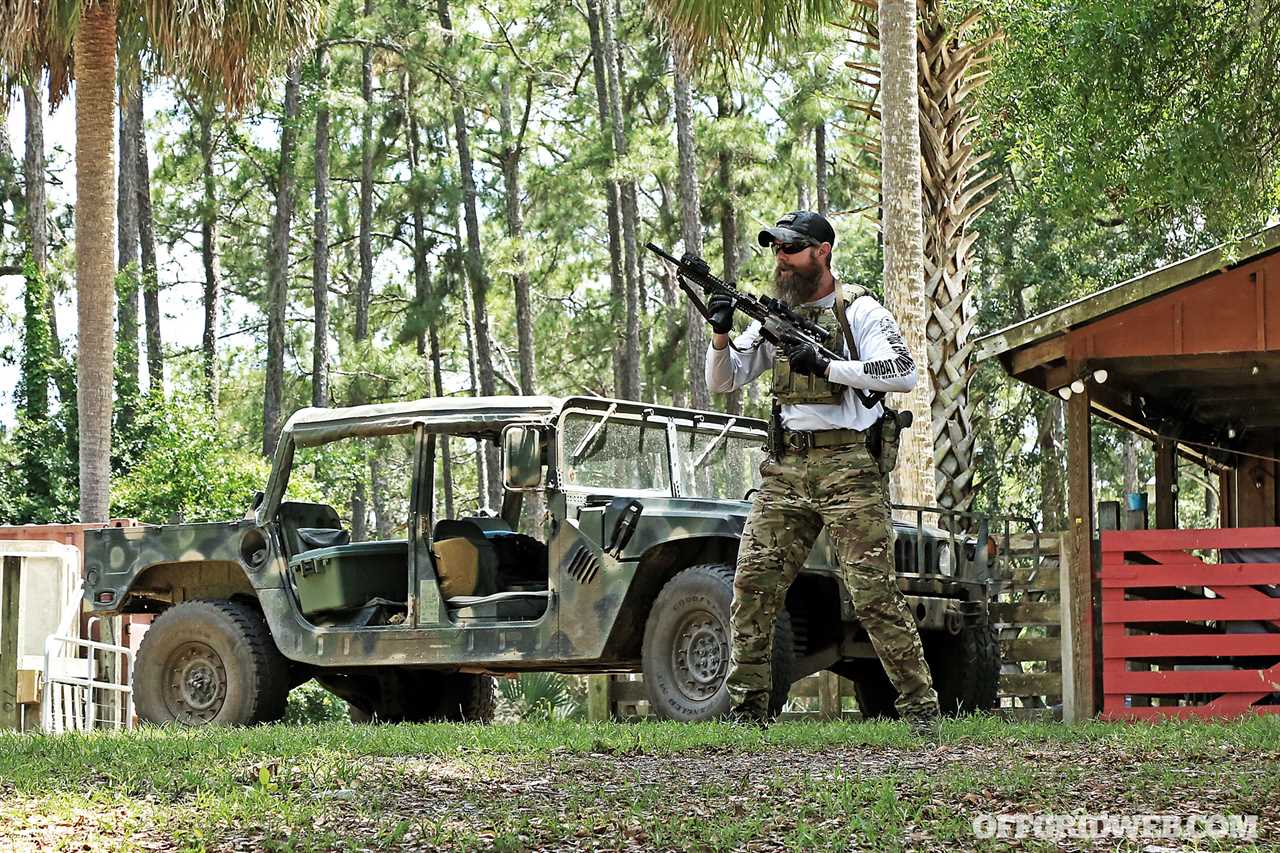
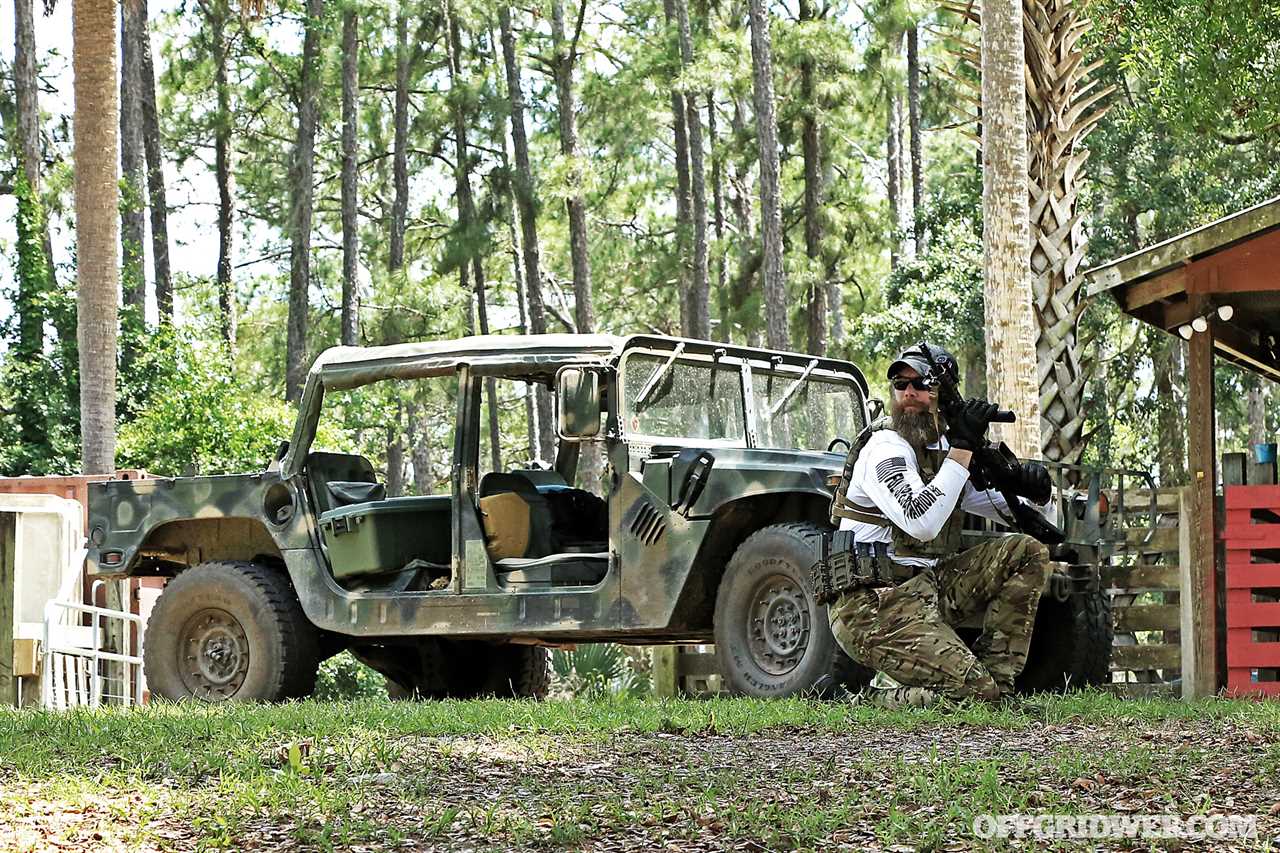
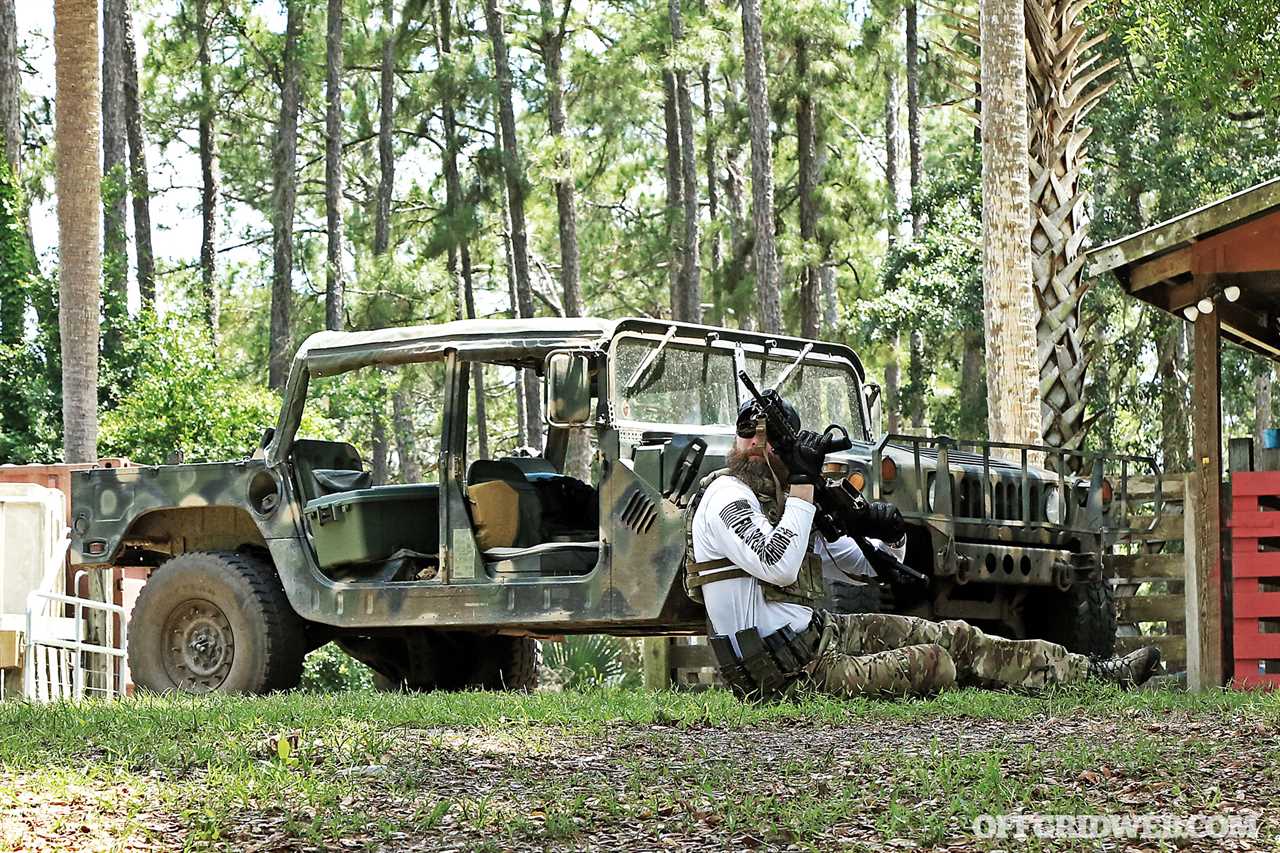
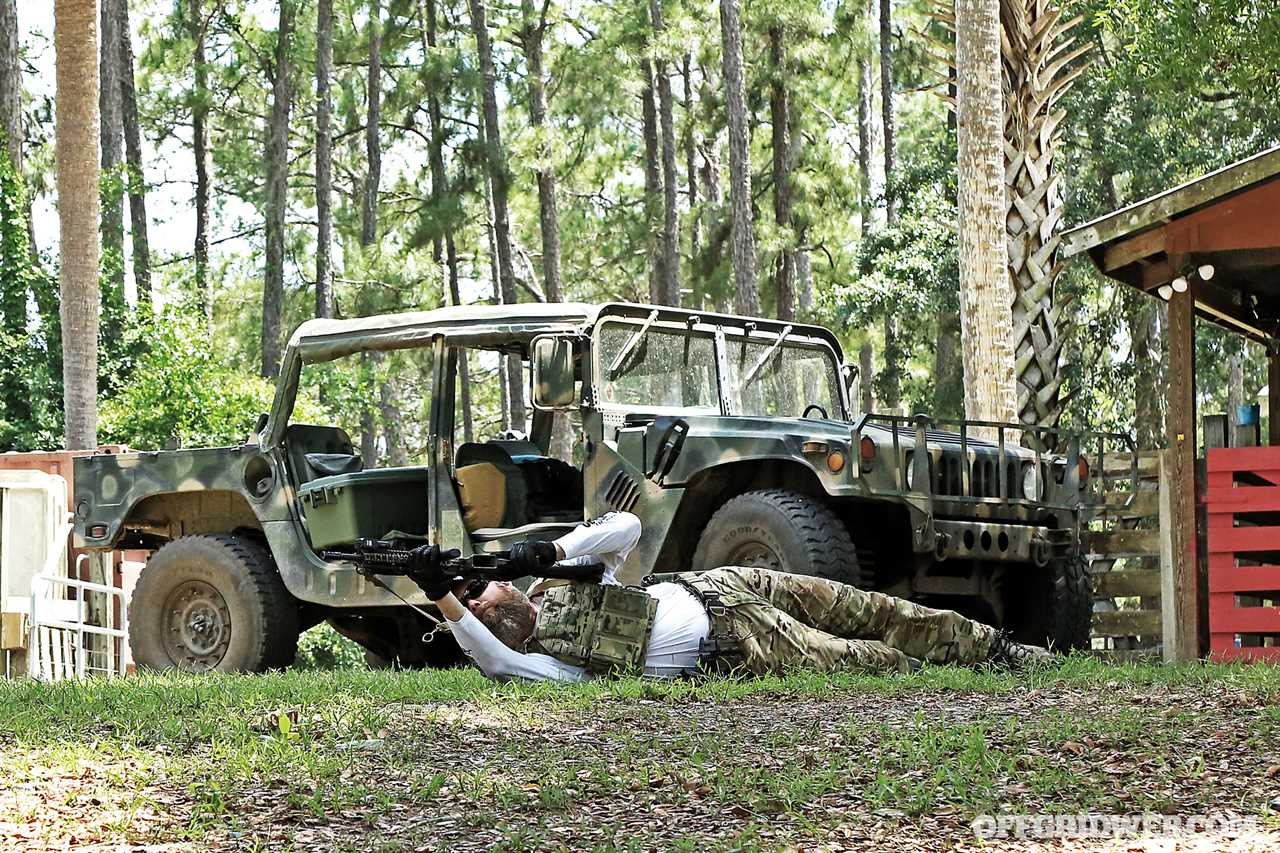

Scanning
Alternately labeled as vital to maintaining situational awareness and absurd range theatrics, post-shoot scanning has been a long-time staple of defensive shooting instruction. I’ll leave the discussion about its viability for another time, but the Combat Mobility System does include it, and includes it in a way I’d not seen before. Most of the scans I’ve seen in the past focused on either simply turning your head to look left and right or, at most, twisting at the waist (with or without moving the gun, depending on who you talk to you) in order to turn your upper body 180 degrees to see behind you.
The CMS version goes, literally, a step further and focuses on moving the entire body from the feet up in a series of 90-degree facing movements. This solves a disconnect between the oft-touted maxim of “360-degree battlespace” and then simply pivoting your head left-right to scan your environment. Moving the entire body a quarter-turn at a time means that you always land in a full fighting/shooting stance, more able to react to unknown sudden-presentation threats.
The following sequence demonstrates the FSW strike-through drill, which drills using the pistol as an impact weapon to create space before shooting:

Graham and Mihovich encapsulated this concept in a drill involving a pivot-based scan that put you face-to-face with a wooden beam held at striking distance. The full-body step-pivot scan turns you into the beam, albeit in a full flush-to-target fighting stance. From this position, you can muzzle strike the beam out of your line-of-sight to engage a target further down range. In the photo sequences here, you see Mihovich demonstrate the drill from a 90-degree scan/pivot, while Graham does it at the end of a complete 180-degree turn. In the latter, you can see he faces each direction in a fully grounded combative stance.
The footwork took me a few reps to pick up, without just spinning around in a circle — a testament to my lack of athletic grace, more than anything else. But Graham broke the footwork down step-by-step after drawing an X in the sand and demonstrating the individual contact points for each foot. It’s laid out here for a 180-degree turn but can be followed through for a complete 360 scan.
The method pictured below breaks a 180-degree turn down into two 90-degree turns, meant to preserve the fighting/shooting stance throughout the turn in the event of unanticipated threats:

Here's a footwork demonstration of the 180-degree turn technique:


Movement and Corners
With more and more conflict occurring in heavily urbanized areas, and structure clearance becoming more accepted as a part of citizen self-defense, movement and cornering have grown in popularity as topics of interest not just for armed professionals but for prepared citizens as well.
Movement drills in large pistol or carbine classes are typically restricted by a combination of range facility limitations (physical or administrative) and student safety in a group environment. What I see most often is isolation of either forward/rearward movement (walking straight up-range or down-range) and lateral movement, which typically focuses on a sideways shuffle step that brings the ankles together, then spreads them apart. Regardless, the principles of shooting while moving, and moving before or after shooting, are valuable ones to understand.
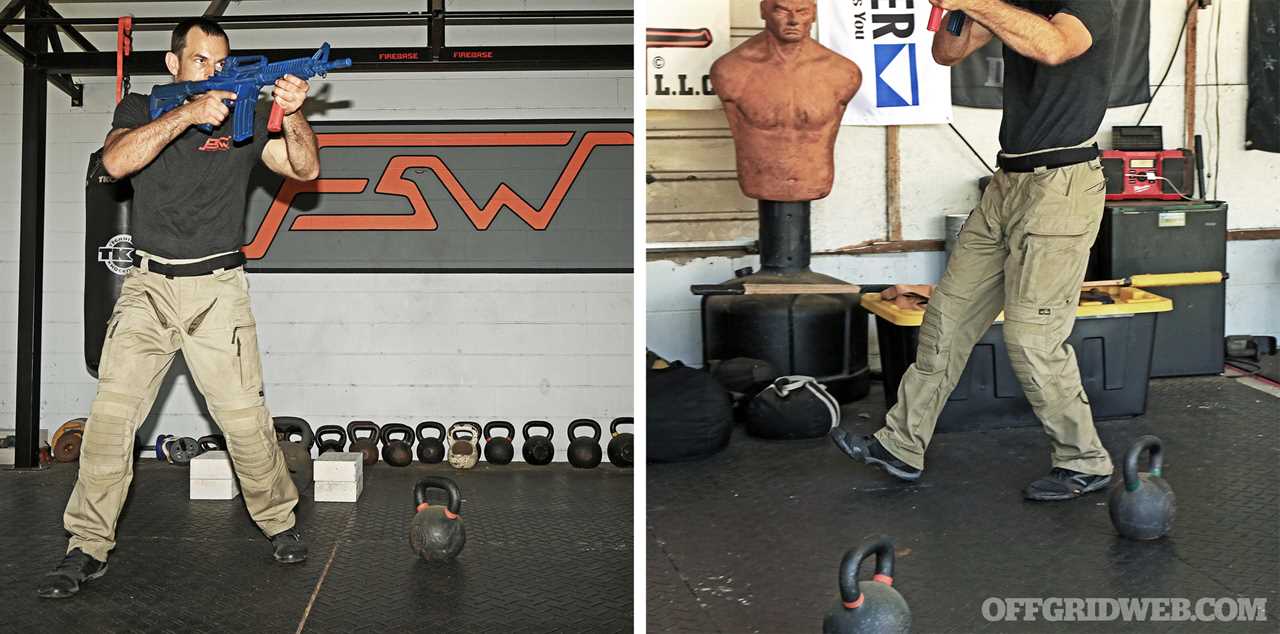
Above: In this demonstration, the upper body traverses toward a target while the hips and legs remain oriented in the direction of travel.
The Combat Mobility System doesn’t isolate movement drills based on direction. In fact, it uses drills that incorporate all directions of motion, including diagonal and even weaving around obstacles, while maintaining weapon orientation toward the target. This is preceded by a block of instruction on muzzle awareness and ready positions to ensure the student can move safely through mixed environments that include friendlies or bystanders. However, I’m going to focus on the mechanics of movement itself.
The previously discussed legacy techniques to teach movement all focus on keeping the entire body oriented toward the target. The CMS method stresses turning the lower body in the direction of motion, pivoting at the hips to change direction as naturally happens when moving unarmed, while independently turning the upper body toward the target. This creates steady, fluid movement and allows smooth flow around obstacles.
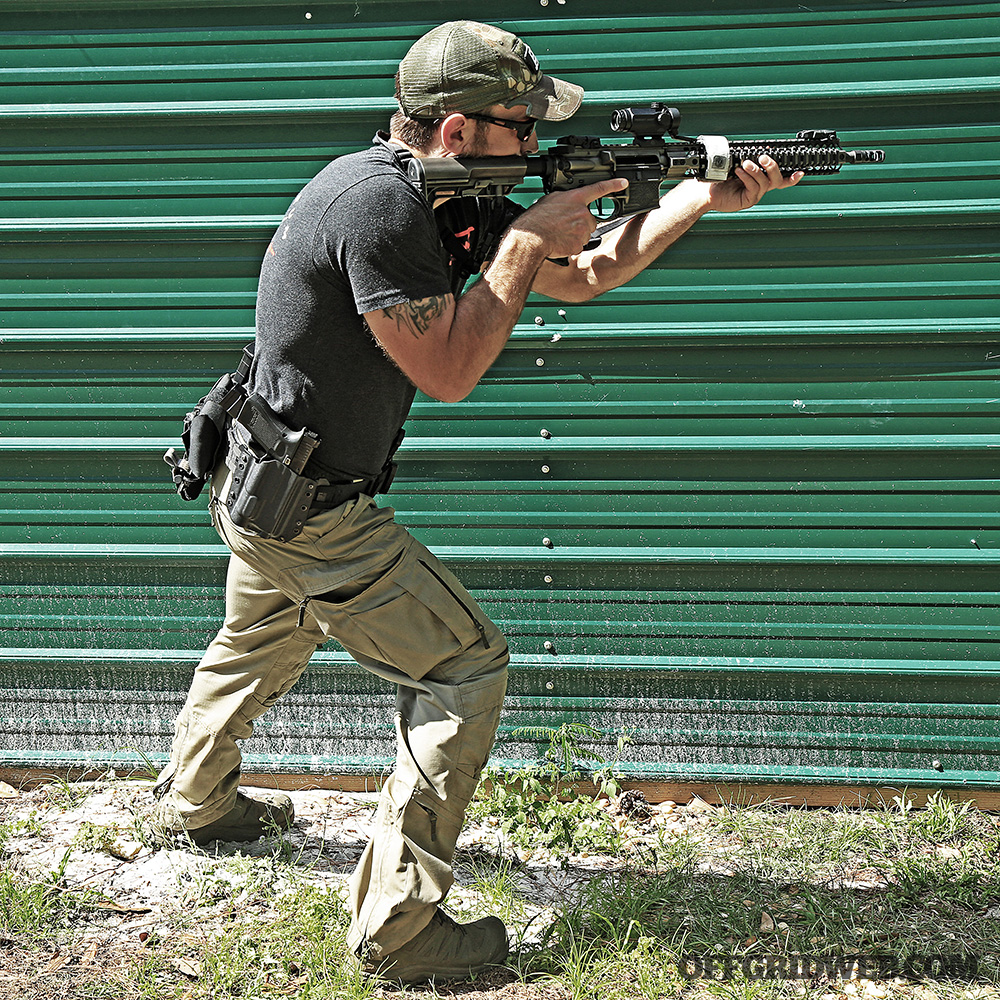
Above: Pieing or panning a corner by shifting weight on the legs or stretching the torso.
Once you introduce movement, in the context of moving through or around structures, you’re almost immediately presented the challenge of corners. Problem-solving corners is, arguably, the fundamental building block of CQB. One of the primary concerns about getting around a corner is balancing the need to get your muzzle and eyeball past the corner without over-exposing the rest of your body and presenting an easy target for potential threats. Because of this, body positioning and movement technique is incredibly important. The most common way I’ve seen this done is by planting the feet and then leaning out by extending the legs or torso just enough to get that muzzle/eyeball line past the corner.
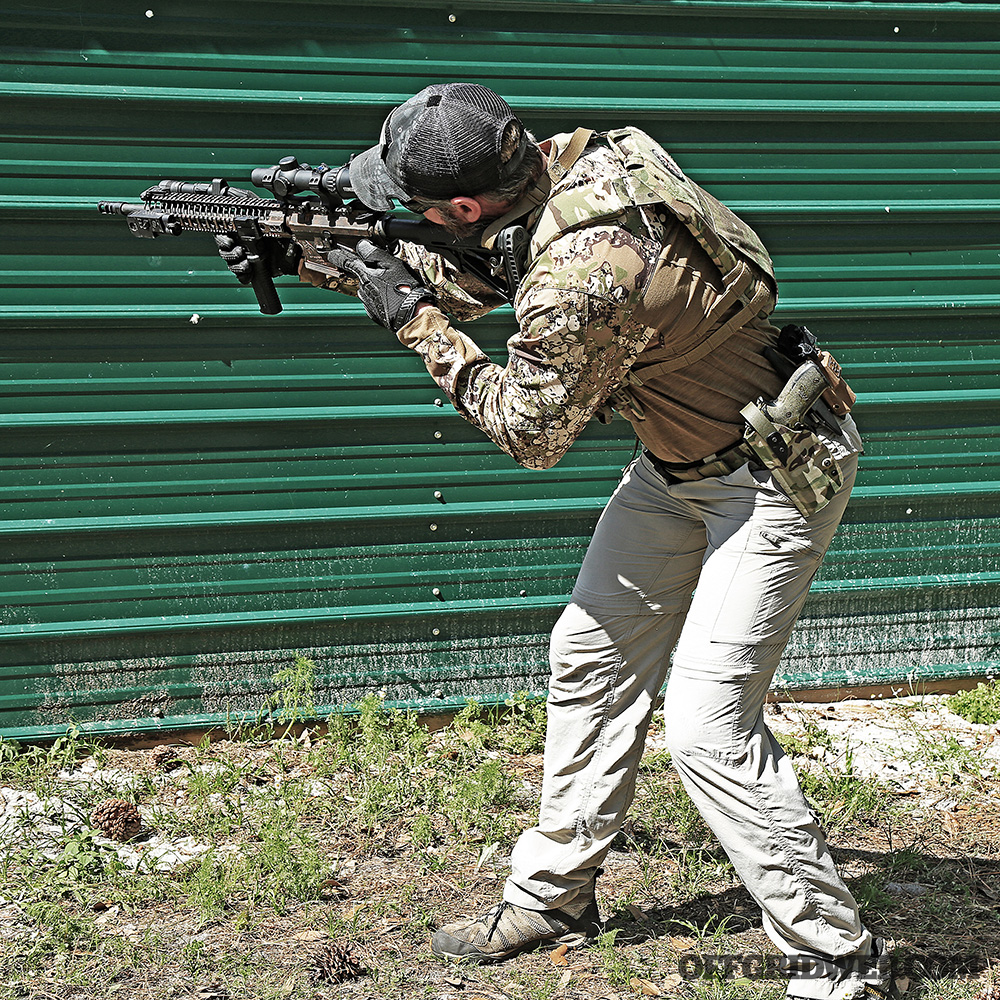
Above: Hinging around a corner by compressing the stance and bending at the hips.
While this method is taught in the Combat Mobility System, Graham and Mihovich also propose an alternate method for getting your body past a corner, which they refer to as hinging. Instead of lengthening the legs or torso to move your body, hinging uses a bending motion with the hips and core. Graham explains that, executed properly, the movement should mimic that of a dead lift. Just as in a dead lift, hinging engages some of the strongest muscle groups in the hips and core to support the weight of the gun and supporting gear — armor, load-bearing equipment, etc.
Using a long plank or PVC pipe gives a visual representation of your bore line in relation to a corner or obstacle:
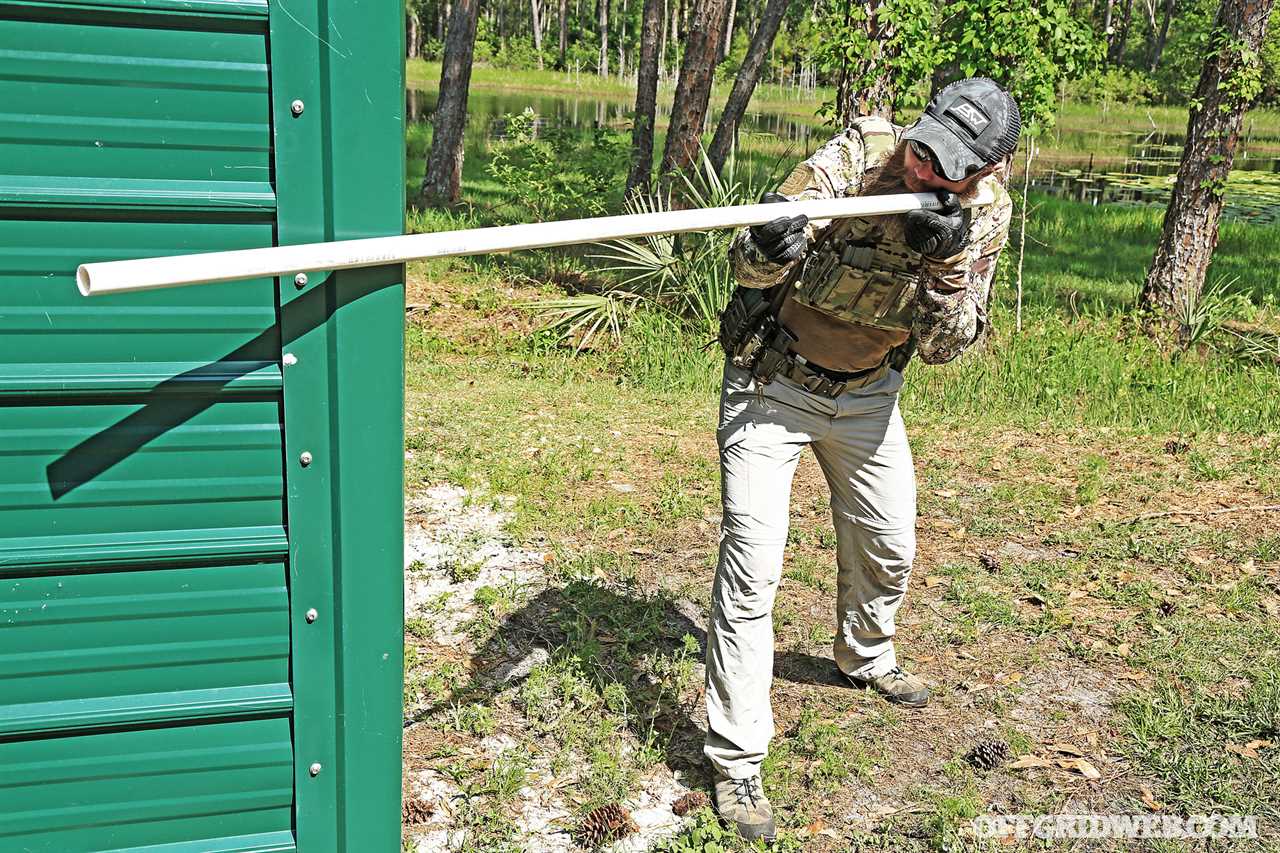
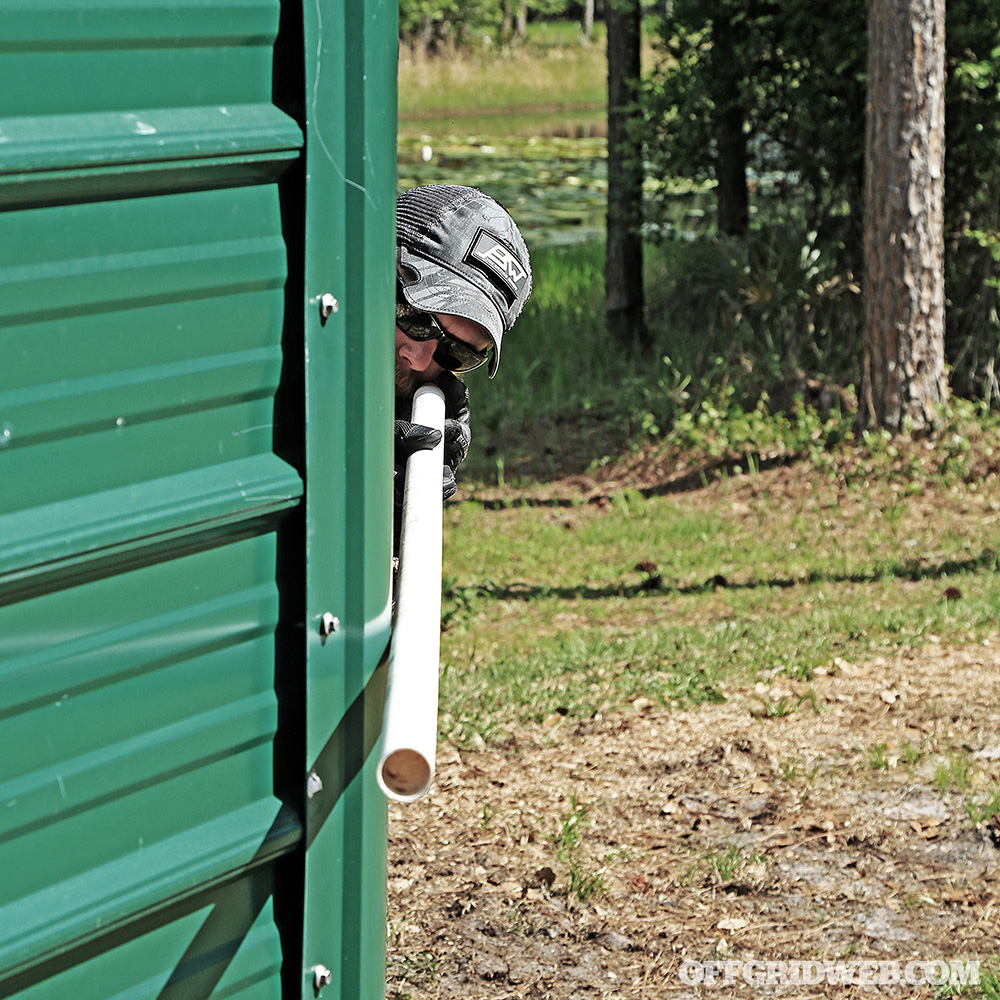
The instructors drove the importance of fine-tuning body position with a drill that uses a length of PVC pipe (thin wood beams, planks, or dowels are acceptable substitutes). The idea is to hold the pipe as you would hold a gun, thus offering an extended “line of sight” for your barrel and eye. Bracing the middle of the pipe on the corner itself allows you to fine-tune your movement — whether you lean or hinge — to get your muzzle past the corner without over-exposing the rest of your body. We found this drill particularly useful for creating a tangible, visual representation of your body position and sight line in relation to the corner itself.
Conclusion
At the end of my time with Full Spectrum Warrior, I came away with a better appreciation for how the human body moves and some new variations on shooting techniques I thought I’d figured out years ago. If you’re unable to make the trip to central Florida to train with FSW in person, they also offer the entire Combat Mobility curriculum as an “online university” you can subscribe to. Their extensive series of videos breaks the whole system down by individual topic, allowing you to study and rehearse the movements at your own pace in the comfort of your own home.
Either way, we suggest checking out Full Spectrum Warrior in person or online and opening your mind to new possibilities of armed movement with their Combat Mobility System.
Full Spectrum Warrior > www.fullspectrumwarriors.com
Related Posts
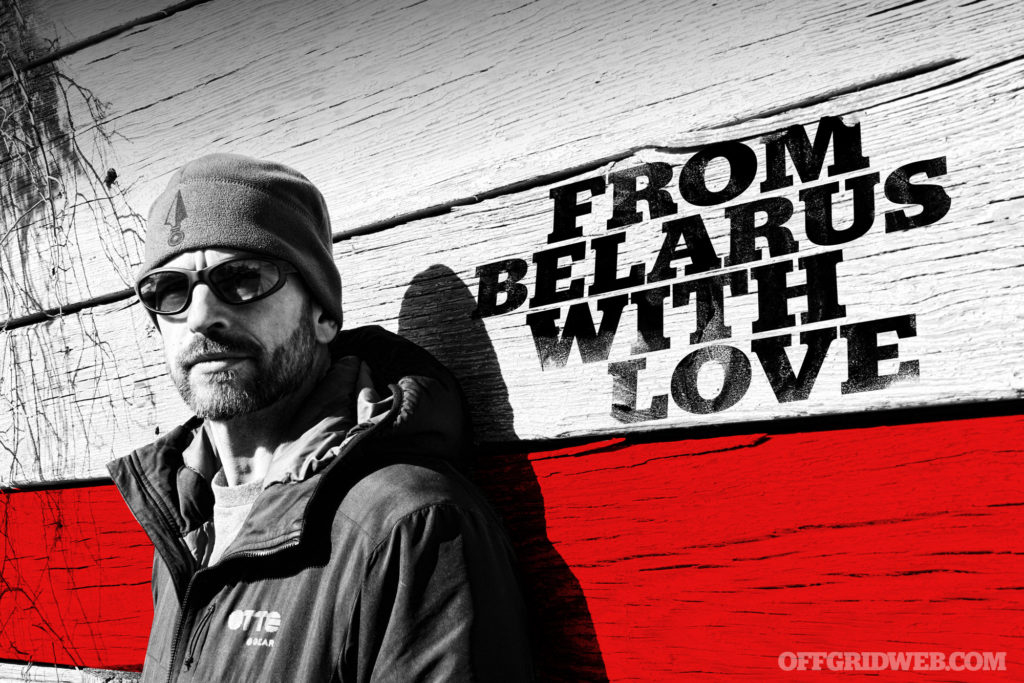
Lessons from a Soviet Union Collapse & Chernobyl SurvivorAfter living through the collapse of the Soviet Union and the fallout of Chernobyl, Greg Mihovich understands the value of preparedness.
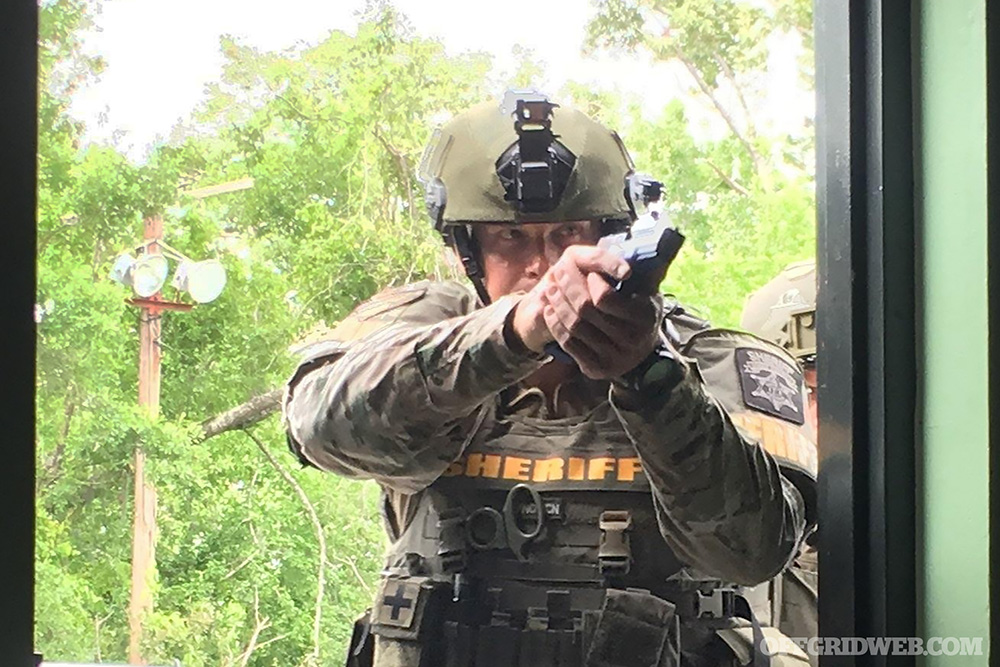
Preparedness Lessons from the Uvalde Mass ShootingPrior to the mass shooting, Uvalde had been like any city in America, not yet a statistic. A disturbed 18-year old changed that forever.
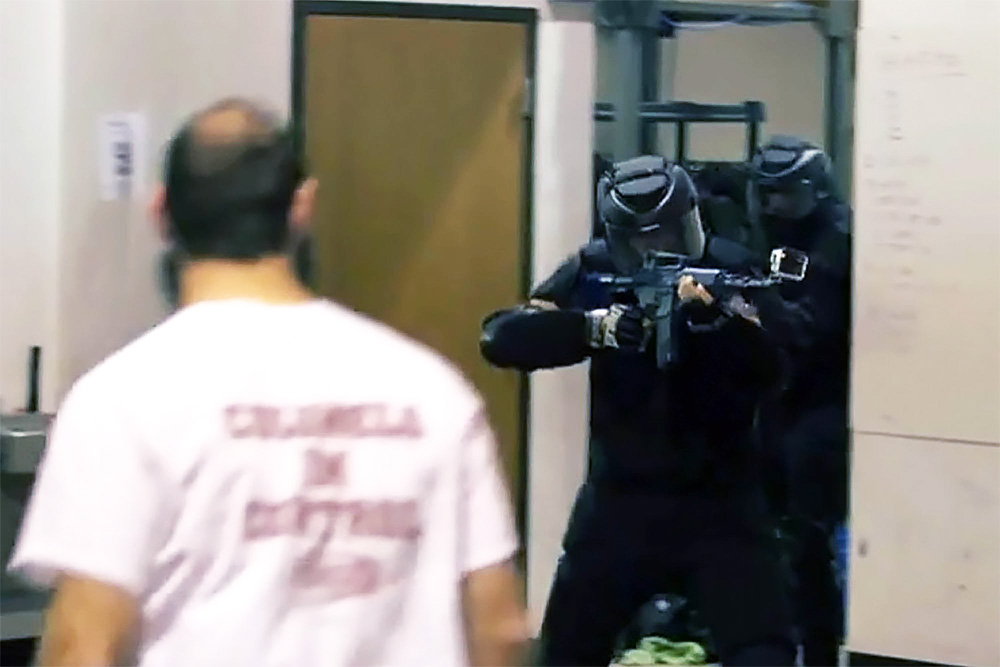
Fools Rush In: Considerations for Engaging an Active ShooterIn this article, we examine how to best survive and solve active shooter scenarios and other complex deadly force encounters.

Safety in Numbers: Preparedness is a Group ActivityOne of the best things you can do to prepare for any emergency scenario is to create a “squad” of like-minded individuals with varied skills.

Preparedness Lessons Learned from the Invasion of UkraineAs preparedness-minded individuals, there's much we can learn from the ongoing conflict in Ukraine. Take a moment to consider these lessons.
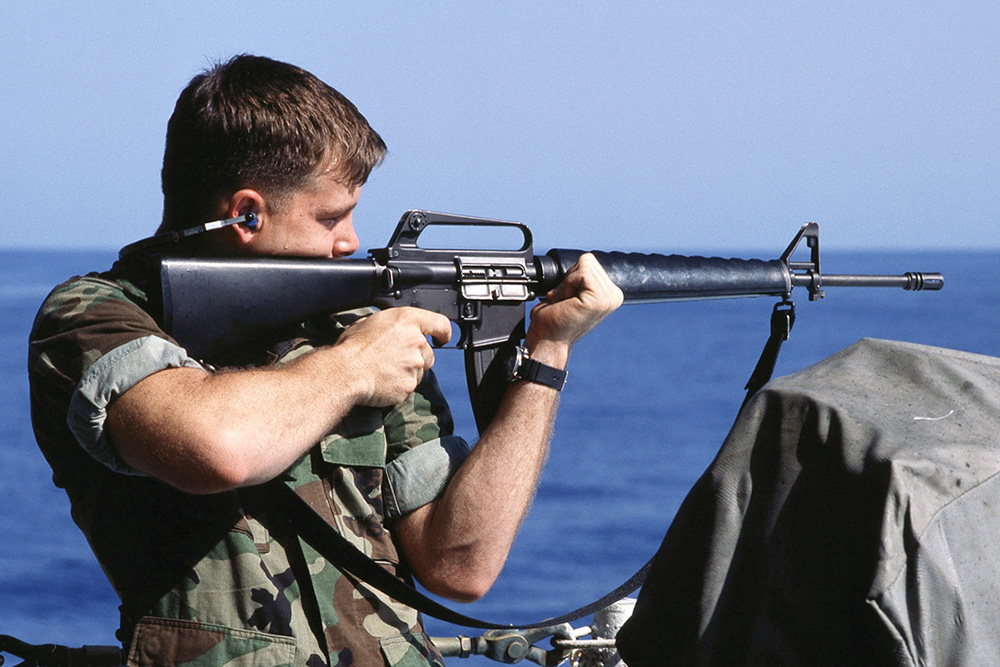
Book Review: “The Book of Two Guns” by Tiger McKeeThe Book of Two Guns is a journal written in the early 2000s that documented lessons learned while training with a 1911 pistol and AR-15.
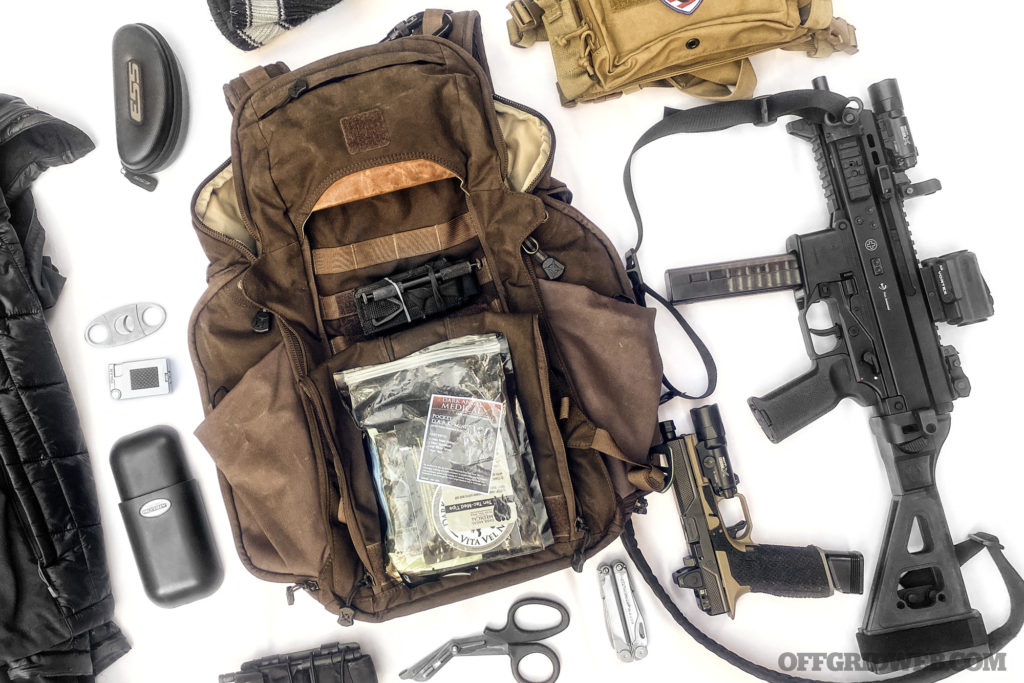
Bag Drop: Personal Security Detachment BackpackThe point of Personal Security Detachment (PSD) is to offer close protection of a high-value individual. You don’t want to look heavily-armed.

Victor Lopez Interview: Founder of Sierra Element Tactical TrainingWe spoke to Victor Lopez to see how he’s combining military and law enforcement experience into his training curriculum at Sierra Element.
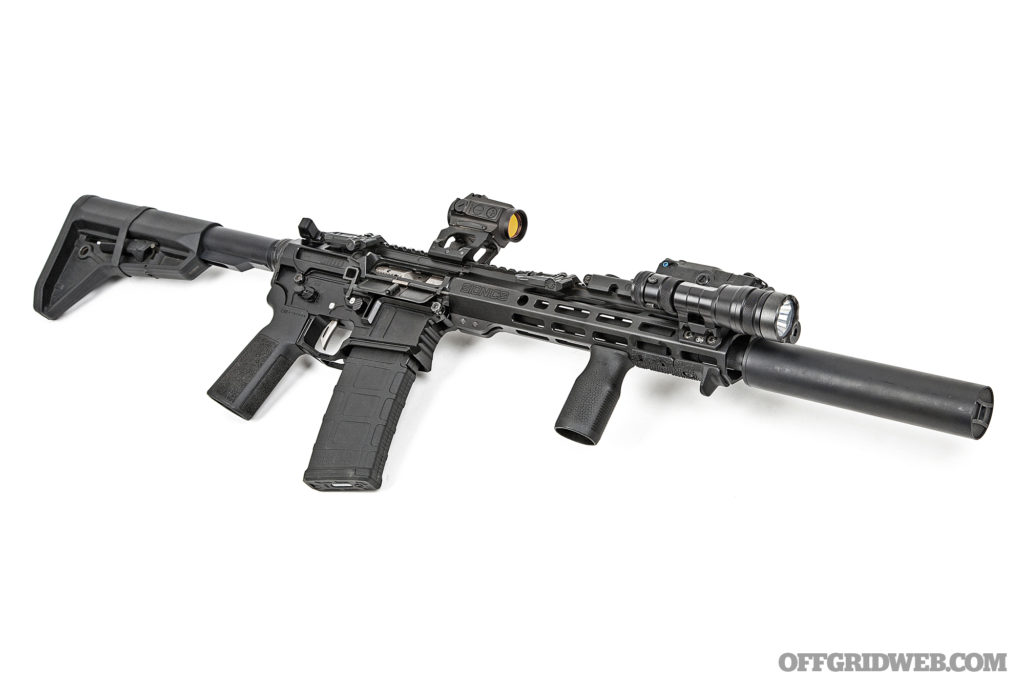
Tailor-Made ARs: 11.5″ Suppressed SBR BuildThis 11.5-inch suppressed SBR features an ambidextrous billet receiver set, night-vision-height red dot, and IR laser/illuminator setup.
The post Smooth Moves: The Full Spectrum Warrior Combat Mobility System appeared first on RECOIL OFFGRID.
By: Tom Marshall
Title: Smooth Moves: The Full Spectrum Warrior Combat Mobility System
Sourced From: www.offgridweb.com/preparation/smooth-moves-the-full-spectrum-warrior-combat-mobility-system/
Published Date: Fri, 05 Aug 2022 11:00:09 +0000
-------------------------------------------------------------------------
Did you miss our previous article...
https://outdoorsnewswire.com/survivalist/stand-your-ground-law-ohio
 CampingSurvivalistHuntingFishingExploringHikingPrivacy PolicyTerms And Conditions
CampingSurvivalistHuntingFishingExploringHikingPrivacy PolicyTerms And Conditions
